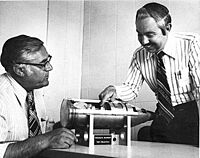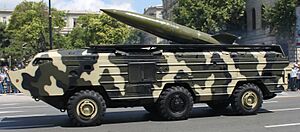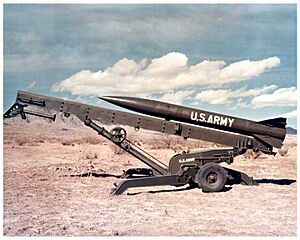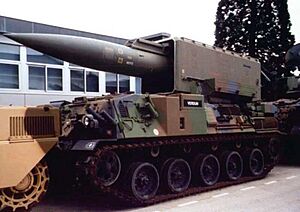Tactical nuclear weapon facts for kids
A tactical nuclear weapon (sometimes called TNW or non-strategic nuclear weapon) is a type of nuclear weapon made to be used on a battlefield. These weapons are often used when friendly soldiers are nearby, or even on land that is being fought over. They are usually smaller in explosive power compared to strategic nuclear weapons. Strategic weapons are designed to hit targets far behind enemy lines, like military bases, cities, or factories, to hurt the enemy's ability to fight a war. As of 2024, no tactical nuclear weapons have ever been used in real combat.
Contents
What Are Tactical Nuclear Weapons?
Tactical nuclear weapons come in many forms. They include gravity bombs, short-range missiles, artillery shells, land mines, depth charges, and torpedoes. All of these are equipped with nuclear warheads. This group also includes nuclear-armed surface-to-air missiles (SAMs) and air-to-air missiles, which can be launched from the ground, ships, or planes.
Some very small tactical weapons were also developed. These could be carried by two people or a truck. Examples include the Special Atomic Demolition Munition and the Davy Crockett recoilless rifle. These small explosives could be used in wartime to destroy important choke points. These might be tunnels, narrow mountain passes, or long viaducts, to stop enemy attacks.
How Powerful Are They?
There isn't one exact definition for how powerful a "tactical" nuclear weapon is, or how far it can reach. Generally, their explosive power (called "yield") is less than that of strategic nuclear weapons. However, some tactical weapons are still very powerful. Some warheads can even change their yield, meaning they can be used for both tactical and strategic purposes. For example, the W89 warhead, which had a yield of 200 kilotons, was planned for both the tactical Sea Lance anti-submarine rocket and the strategic SRAM II missile launched from bombers.
Modern tactical nuclear warheads can have yields up to tens or even hundreds of kilotons. This means they can be several times more powerful than the atomic bombs used in Hiroshima and Nagasaki.
Some tactical nuclear weapons have special features for battlefield use. For example, variable yield allows their explosive power to be changed for different situations. There are also "enhanced radiation weapons," sometimes called "neutron bombs." These are designed to create a lot of ionizing radiation but cause less blast damage.
Tactical Weapons During the Cold War
Tactical nuclear weapons made up a large part of the nuclear weapons stored during the Cold War.
As the ended in 1991, the US and the USSR (now Russia) removed most of their tactical nuclear weapons. They also got rid of many of them. In the late 1980s, both sides had thousands of these warheads. By 2021, the US had an estimated 230, and Russia had between 1,000 and 2,000, though Russia's numbers vary.
Yield Differences
The explosive power of a tactical nuclear weapon can range from a small part of a kiloton to about 50 kilotons. In comparison, a strategic nuclear weapon usually has a yield from 100 kilotons to over a megaton. Much larger warheads are also available for strategic use.
Risk of Conflict Growing
Using tactical nuclear weapons against an enemy who also has them carries a big risk. It could make a conflict much worse, turning a small fight into a full-scale strategic war. Small, low-yield tactical nuclear warheads might be used more easily during a crisis than much larger warheads. For example, a W54 warhead had an explosive power of only 10 tons of TNT.
The use of tactical nuclear weapons could lead to a point where strategic nuclear weapons like ICBMs are used. Also, the smallest tactical nuclear weapons, like nuclear artillery from the 1960s, used to have less strict political control during military crises than strategic weapons. Early safety systems were sometimes as simple as a combination lock. If a lower-ranking officer in charge of a small tactical nuclear weapon, like the M29 Davy Crockett, was about to be overrun by enemy forces, they might ask for permission to fire it. Because control was less centralized, their request might be quickly approved during a crisis.
Because of these risks, most countries have greatly reduced their tactical nuclear weapon stockpiles since around 2010. The smallest types have been completely removed. Also, modern safety systems, called "Category F" PAL mechanisms, are much more advanced. These systems, along with better communication, mean that a country's top political leaders can now keep central control over tactical nuclear warheads, even during combat.
Some variable yield nuclear warheads, like the B61 nuclear bomb, have been made in both tactical and strategic versions. The lowest selectable yield for a tactical B61 (Mod 3 and Mod 4) is 0.3 kilotons (300 tons). Modern PAL systems make sure that central political control is kept over each weapon, including how powerful its explosion will be.
With the B61 Mod 12, the United States will have 400 identical nuclear bombs. Whether they are considered strategic or tactical will depend only on their mission, target, and the type of aircraft carrying them.
Some reports suggest that after the USAF used precision munitions in the Kosovo conflict, which caused little extra damage but achieved strategic destruction, Vladimir Putin, then-secretary of the Security Council of Russia, developed a new idea. This idea, called "escalate to de-escalate," involves using both tactical and strategic nuclear threats and strikes to end a regular conflict that threatens Russia's important interests. However, other experts disagree on whether Russia has lowered its rules for using nuclear weapons.
Treaties and Control
Ten NATO member countries have suggested a plan for NATO and Russia to build trust. This plan could lead to treaties to reduce the number of tactical nuclear weapons in Europe.
As of 2012, NATO was planning to upgrade its tactical nuclear weapons with precision guidance. This would make them as effective as strategic weapons against strong targets. They would also be carried on stealth aircraft, which are much harder for current air defenses to detect.
Recent Discussions on Use
During the Russian invasion of Ukraine, there has been ongoing talk about whether Russia's president Vladimir Putin might use a tactical nuclear weapon. This could be against Ukraine or as a warning strike over empty areas. This discussion comes because the war has not gone as the Kremlin expected, and some Russian government members have threatened to use nuclear weapons.
On March 25, 2023, President Putin announced that Russia would place tactical nuclear weapons in Belarus. Russia would still control these weapons. As of May 2023, these weapons are a small number of Iskander missile warheads. Russia plans to finish a storage facility for tactical nuclear weapons by July 1. President Putin told Russian state television, "There is nothing unusual here either…Firstly, the United States has been doing this for decades. They have long deployed their tactical nuclear weapons on the territory of their allied countries." In December 2023, Belarusian president Alexander Lukashenko said that the nuclear weapons deliveries were finished in October.
In May 2024, Vladimir Putin announced that Russia would hold drills with tactical nuclear weapons. This announcement came days after he responded to comments from senior Western officials.
Examples of Tactical Nuclear Weapons
- B43 nuclear bomb
- B57 nuclear bomb
- B61 nuclear bomb Mod-3, Mod-4, Mod -10
- Blue Peacock
- Nasr (tactical nuclear missile)
- W25 (nuclear warhead)
- W33 (nuclear weapon)
- W80 (nuclear warhead)
- W85 (nuclear warhead)
- Category:Nuclear mines
- M-28 & M-29 Davy Crocketts with W54 nuclear warhead
- Medium Atomic Demolition Munition
- Shaurya
- Red Beard
- Special Atomic Demolition Munition
- Nuclear artillery
See also
- List of nuclear weapons






